Worth the wait – Jaguar XJS Convertible at 30
Reproduced with permission of Jaguar World magazine (May 2018)
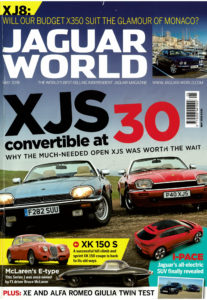
Jaguar World
May 2018
The buying public had to wait more than a decade after the XJS launch for a full convertible version to finally became available. On its 30th anniversary, we look into why, and the impact the model had on Jaguar’s image.
THIRTEEN YEARS. That’s how long it took for Jaguar to introduce a full convertible based on the XJ-S. Most cars don’t have a model life that lasts that long. Yet despite the delay, when the XJ-S convertible finally arrived in 1988 it became one of Jaguar’s most successful models. Along with the major facelift in 1992, the soft top helped to extend the XJS’ desirability well until the Nineties.
There should never have been a delay, though. When the XJ-S’ designer, Jaguar’s aerodynamicist Malcolm Sayer, began work on a new sports car in September 1968, he made provision for both a coupe (XJ27) and convertible (XJ28). It would use XJ6 parts and be very different from the outgoing E-type: larger, more refined and, according to a memo from Sayer to Sir William Lyons, “…a low, wide, high-speed car, at least as eye-catching as the Italians will produce.”
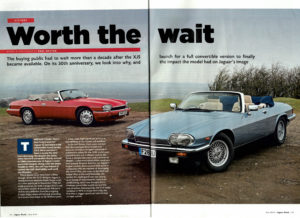
Jaguar World – May 2018
Worth the wait – XJS Convertible
P40 XJS Pages 24-25
In the late Sixties, there were rumours that the American Government was about to introduce stringent standards in automotive safety for the 1980 model year. Central to this was a 50 mph crash to the front, a 25 mph side crash, and a rollover at 30 mph – a test most convertibles could not have passed. Because America was Jaguar’s largest market, there seemed little point in continuing with the expense of developing the convertible, and work on the XJ28 was halted. Plus, in the Seventies, the market for small sports cars was drying up in favour of more luxuries, such as air conditioning, and it was thought that a frivolous convertible would not suit this new direction. Consequently the XJ-S made its debut in 1975 in coupe form only, the first time a Jaguar sports car had not had an open option.
The legislation, of course, never appeared in such a severe form. By the early Eighties, full convertibles were starting to make a comeback, with models such as the the 1982 Ferrari Mondial, and the Ford Mustang the following year. Jaguar, though, wasn’t in a position to join them. Down to producing just 14,000 cars a year by 1980, production of the unpopular XJ-S all but stopped, and the company lacked the resources to develop a new model.
When a new chairman took over in 1980 – the former Massey Ferguson director John Egan – he knew an open car would improve Jaguar’s fortunes. “We thought that to revitalise the car some kind of convertible was the way to go,” he told Jaguar World Monthly in July 2012.
In the short term, the solution was the XJS cabriolet. Although the crossbrace hoop over the cabin negated the need for serious underbody strengthening and was, therefore, easier to develop than a full convertible, the cabriolets were still expensive and complicated to produce because they were converted from unfinished coupe bodies by the Coventry coachbuilder Park Sheet Metal. As a result, they were only made to order. Despite that, the cabriolet still sold well thanks to its handsome looks and and the introduction of the economical AJ6 3.6 engine. More than 5,000 were manufactured between 1983 and 1987, endorsing the idea that a full convertible was the sensible step.
This decision was further supported when independent coachbuilders started producing their own, such as Lynx in the UK and America’s Hess & Eisenhardt, the latter available through Jaguar’s own dealer network. Although an expensive conversion, 180 Lynx spiders were produced between 1976 and 1983.
Jaguar’s fortunes had been rising thanks to an improvement in the quality of its cars, and in 1985 a project team of 12 members was assembled for a factory version. The line-up included staff from across engineering, design and marketing and was headed up by Jaguar’s director for new programme engineering, Ken Giles, to ensure this important car was right. Said Giles in Brian Long’s The Book of the Jaguar XJ-S, “The chairman’s brief to us was typically straightforward – he wanted a world-class convertible, and we had to have a saleable vehicle on our stand at the 1988 Geneva show and be able to start selling cars in the UK and Europe by May 1988.”
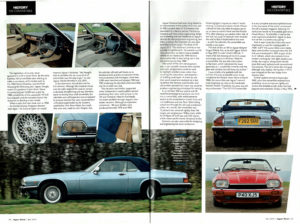
Jaguar World – May 2018
Worth the wait – XJS Convertible
P40 XJS Pages 26-27
| 1988 XJ-S 5.3 convertible | 1996 XJS 4.0 convertible | |
| Engine | 5,343 cc, V12 | 3,980 cc, 6cyl |
| Power | 299 bhp | 223 bhp |
| Torque | 318 lb ft | 278 lb ft |
| 0-60 mph | 8.0 secs | 7.2 secs |
| Max speed | 146 mph | 145 mph |
| Transmission | 3-speed auto | 4-speed auto |
| Price new | £36,000 | £45,950 |
| Value now | £15,000 | £25k-£30k |
The speed of the car’s development was in part possible because then-current computer programmes could be used to highlight problem areas rather than incurring the extra time – and expense – of building prototypes. A mock-up was then constructed and analysed on a test rig before the German coachbuilder and convertible specialist Karmann was asked to produce engineering prototypes for testing.
It would take 108 new panels and 48 modified pressings to transform the XJ-S into a convertible, with reinforcements added to the transmission tunnel, front and rear bulkheads and rear floor. Steel tubing would run through the sills and windscreen pillars. As a result, the convertible had 15 percent less torsional rigidity than the coupe, yet weighed just 100 kg more, while its Cd figure of 0.39 was only 0.01 higher.
Karmann was also responsible for designing and engineering the hood mechanism. Following Egan’s request to make it ‘world-beating’, it received an electric hood. Almost unheard of (the only other European sports car to have an electric hood was the Porsche 911), after releasing two catches either side of the roof rail, a pair of hydraulic rams lowered the roof so that it folded behind the seats – as with the cabriolet, the convertible was initially a two-seater.
The look of the car fell to Jaguar designer Fergus Pollock, but, as he told Jaguar World in May 2017, he didn’t find it difficult. “I made a full-size drawing of the XJ-S coupe and simply taped on the lines I liked for a convertible. We sent this information to Karmann, which calculated the hood geometry so it would fold correctly with the glass rear window, but still keep my outline.”
It was initially only available with the 5.3-litre V12 and, and at £36,000 when it was revealed at the Geneva motor show in March 1988, the convertible was Jaguar’s second-most expensive car, next to the handmade Daimler DS420. Thankfully, the press was still very enthusiastic. “The XJ-S V12 convertible is a very complete and accomplished tourer in the true sense of the word,” announced the UK’s Autocar magazine following the April press launch on the suitably glamorous French Riviera. “At £6,000, it may be the most expensive production Jaguar to date, but we feel it is worth every penny.”
And it wasn’t just the critics who were impressed; so was the buying public. In 1989, 4,877 V12 convertibles were made. Sales were further increased when the 4.0 AJ6 was introduced in 1991 as part of the XJ-S’ refresh, which also included more modern rectangular rear light clusters and, inside, the original idiosyncratic barrel-type dials were replaced with conventional instruments. The car’s name also changed, although only slightly: the hyphen in XJ-S was dropped on the rear badge from thereon after.
Further updates arrived in September 1992, when the convertible received front underfloor struts to improve rigidity and remove the dread scuttle shake that had plagued early examples.. Finally, in May 1993, with a new sub-assembly welded on top of the existing underframe and the roof’s hydraulic pump having been relocated to above the battery in the boot, the convertible finally received rear seats (the original storage box remained available as a special order).
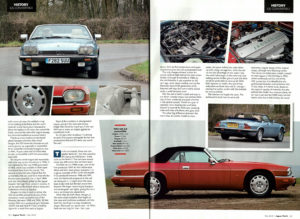
Jaguar World – May 2018
Worth the wait – XJS Convertible
P40 XJS Pages 28-29
Thanks to more colour-keyed plastic bumpers and new alloy wheel designs, the XJS remained a handsome and contemporary car, especially in convertible form. Customers obviously thought so too; in 1994, 19 years after the XJ-S first went on sale, an incredible 4,633 4.0 convertibles were sold.
Yet despite continuing to sell reasonably well, time was up for the old car. In 1996, it was replaced by the X100-generation of XK8, which was available in both open and closed form from the outset. The second-to-last XJS was a Signal Red 4.0 convertible (the car used here) that left the Browns Lane assembly line in April 1996 and was immediately gifted to the Jaguar Daimler Heritage Trust, where it remains. It can be seen at the British Motor Museum’s Collections Centre at Gaydon.
Despite the time it took to arrive, the XJS convertible proved to be one of the company’s most successful cars of the Nineties. Between 1988 and 1996, 30,946 topless XJS were produced (split between 14,297 4.0s and 16,469 V12s), a healthy figure for a small firm such as Jaguar.
Beyond the numbers it reinvigorated Jaguar, giving it the more glamorous image that would be important if the new XK8 was to make an impact against its established rivals.
So, 30 years after its debut, I’m driving an early V12 alongside the last one produced to find out if it really was worth the wait.
To the uninitiated, these two cars appear identical – but that would be like saying the XJ6 Series 1 is the same as the Series 3. The cars have several minor key differences that set them apart.
The blue car is a 1988 model, one of the first produced. With its 16in lattice-style alloys and slim, black plastic bumpers, it is a typical example of the 13,197 pre-facelift V12s produced between 1988 and 1991, now old fashioned compared to the red car alongside it. It might share the same basic body shell, but the last convertible features the larger colour-keyed bumpers and rectangular rear lights, giving the car a more contemporary appearance.
What they do both share, though, is the same single bodyline that begins at the nose and continues unabated until the boot lid, resulting in a crisp, handsome shape. Obviously not sports cars – at 192in, both are too long for that – but, tops down, their perfect proportions and squat appearance gives the cars a purposeful look.
The only disappointment is that the canvas roofs sit high behind the seats when folded. Although acceptable in 1988, by the mid-Nineties it was a pointer to the car’s age, since newer models, such as the Mercedes-Benz R129 generation of SL, featured soft tops that were neatly stored under a solid tonneau cover.
Still, the roof of both is quick and easy to put down. I simply release two catches either side of the front screen rail and push a button in the central console. Thanks to a pair of hydraulic rams, lowering the roof takes around 12 seconds for both cars, revealing miles and miles of brilliant, em, grey skies.
The other big difference between the two is that the earlier model is a two-seater, the space behind the seats taken up with a large storage box, while the red car has the advantage of rear seats. I use the word ‘advantage’ in the same way that walking across broken glass in just one shoe would be preferable to none at all. With little legroom or width, they are all but redundant and best reserved for storage – making the earlier model with the lockable lid more practical.
The interiors are largely the same. The dashboard in both has the same old-fashioned, angular design of the original coupe, although now featuring veneer. The red car is a Celebration model, created to mark Jaguar’s 75th birthday in 1994, which continued until the end end of the XJS’ production. It is identified by the gold bonnet Growler and handsome 16in 11-slot alloys. It is better built, thanks to the superior quality of materials that also defined the model. As a museum piece, the car hasn’t reached 7,000 miles, but the leather does feel a little thicker, the wood shinier and, instead of the earlier models’ unusual barrel-style instruments for the temperature, oil pressure, fuel and voltmeter, the later car’s six circular dials make it look and feel more modern, although it does lose a little of the XJS’ character.
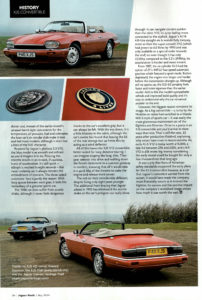
Jaguar World – May 2018
Worth the wait
XJS Convertible
P40 XJS Pages 30
Powered by Jaguar’s glorious 5.3 V12, the blue model is as smooth and refined as you’d imagine it to be. Pressing the throttle results in an instant, if cautious, burst of acceleration. It’s still quick – 60 mph is reached in eight seconds – but never violently so; it always remains the embodiment of restraint. The three-speed automatic ‘box is partly the reason. With long spaces between each gear, it lacks the immediacy of a genuine sports car.
The 1988 car does suffer from scuttle shake, although it never feels dangerous thanks to the car’s excellent grip; but it can always be felt. With the top down, it is a little blustery in the cabin, although the car’s owner has found that leaving the lid of the rear storage box up limits this by acting as a wind deflector.
All of this leaves the XJS V12 convertible better suited for long-distance touring. I can imagine slipping the long, thin, T-bar gear selector into drive and wafting down the French Autoroute to a summer getaway in comfort, knowing that all it would take is a quick blip of the throttle to wake the engine and release more power.
The red car feels considerably different, despite being only eight years younger. The additional front bracing that Jaguar added in 1992 has eliminated the scuttle shake so the car’s pedigree can really shine through. It can navigate corners quicker than the older V12, its tyres feeling more connected to the asphalt. Jaguar’s AJ16 4.0-litre straight-six is wonderfully torquey, more so than the super-smooth V12 (which had grown to 6.0 litres by 1993 and was only available as a special order towards the end) so even though it has only 223 bhp compared to the 5.3’s 299 bhp, its acceleration is harder and more instant.
From 1987, the six-cylinder XJ-S had the option of ZF’s 4HP22 four-speed automatic gearbox which featured a sport mode. Button depressed, the engine revs longer and harder before the transmission changes up. Although still no sports car, the XJS 4.0 certainly feels faster and more vigorous than the earlier model. Add to this the model’s sympathetic refresh and improved build quality and it’s easy to understand why the car remained popular to the end.
However, the biggest reason remained its image. As a big convertible – a rarity by the Nineties as tastes had switched to a Mazda MX-5-style of sports car – it was easily the most glamorous mainstream car of the Eighties and Nineties. Drive to a party in an XJS convertible and you’d arrive in more ways than one. That is still the case, 22 years after production finished, explaining why values have risen in recent months. An early XJ-S V12 is today worth £15,000, a late 4.0 between £25k and £30k, and a 6.0 V12 is £5k more: big money considering the early model could be bought for only a few thousand not that long ago.
It was pity that fears of American safety standards scuppered the early plans for the XJ-S convertible because, as a a car that Jaguar’s customers wanted from the outset, it would have made the company more financially secure as it entered the Eighties. Its success and the positive impact on the company’s revitalised image shows how much it was worth the wait.
Thanks to:
- XJS V12 owner Howard Seymour
- The XJS club (www.xjsclub.org)
- The Jaguar Daimler Heritage Trust (www.jaguarheritage.com)
Words: Paul Walton
Photography: Paul Walton